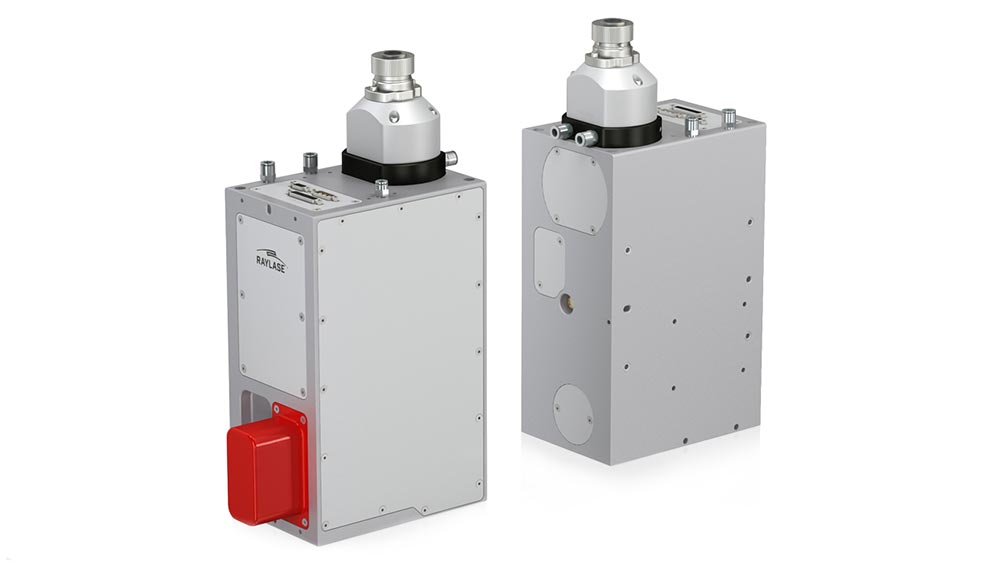Welding copper in power
electronics for e-vehicles
Which scan system is best for welding copper connections in power electronics for e-vehicles?
In terms of future potential, e-mobility is still on the starter blocks. Together with fuel cell technology, it is currently considered the most ecological option for vehicles. The electric drive in cranes, forklifts, trains and ships, and especially in electric cars, consists of the electric motor, battery and at the heart of it all - power electronics. The latter serves as the control centre between the electric motor and the battery. Within it, electrical energy is controlled, converted or switched by electronic components. In e-cars, for example, power electronics convert the battery‘s high-voltage current into low-voltage current for lights and navigation systems or entertainment systems. Put simply: in e-mobility, nothing moves without power electronics.
In recent years, these power electronics have become increasingly complex and, at the same time, smaller and smaller. This presents a huge challenge for production. The reason being that up to 4.000 components need to fit into casing no bigger than a shoebox. That is one high-tech power pack.
Laser technology is ideal for power electronics
Modern laser technology with its opto-mechanical deflection units is ideally suited to power electronics in e-mobility. Particularly in the production steps of cleaning, cutting, joining, and especially in the welding of delicate copper joints, innovative laser deflection units bring multiple advantages. They ensure reliability by providing repeatable process stability, reduce the effects of temperature and increase dynamics and flexibility. In doing so, they boost the load capacity of a battery regardless of whether it is exposed to low or high temperature conditions. With modern laser deflection units, it is now possible to manufacture in the smallest of spaces with unsurpassed quality.
Product solutions:
RAYLASE offers machine builders and power electronics manufacturers laser beam deflection units for battery management that offer a wide range of configuration options for welding very thin copper joints.
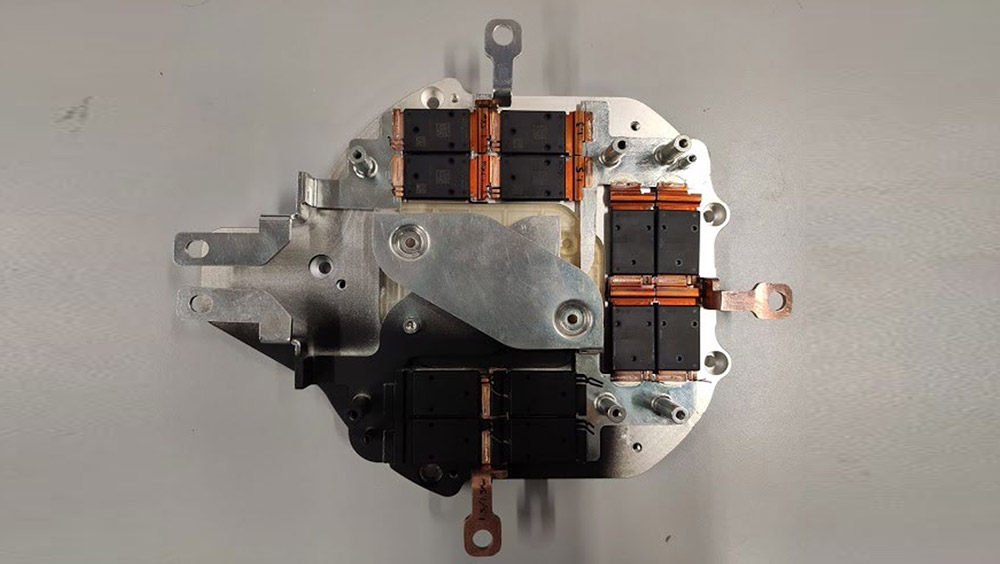
The black press pack power components are particularly robust and powerful. They are used in numerous electric cars. Source: Tecnosens
WELDING COPPER SHEETS TO POWER COMPONENTS
In power electronics, conventional joining techniques reach their physical limits due to the ever-increasing currents and wire
diameters. A power component that is becoming more and more common these days is the so-called press pack. A type of IGBT (insulated-gate bipolar transistor) module, this semiconductor device is used in the e-mobility industry for battery management systems.
MAXIMUM PRECISION AND ABSOLUTE PROCESS RELIABILITY
Welding the very thin copper connections used here to the press- pack is an extremely critical process. Two wafer-thin layers of CU ETP must be connected each with a thickness of only 0.4mm. In a second step, the lower copper sheet is welded to a tinned copper busbar of 4mm. The process needs to be very precise and safe, an imperative in battery management.
STRONG COPPER CONNECTIONS FOR A GOOD CURRENT FLOW
Laser scanners from RAYLASE are the ideal deflection units for this process using corresponding optics such as the SUPERSCAN IV-15 for fast wobble or the AXIALSCAN FIBER 20/ -30 for larger fields up to a total laser power output of 4 KW. They help create the appropriate weld pool homogeneity and keep the heat-affected zone stable near the beam irradiation point, or to limit the temperature around nearby sintered components. Additionally, weld spatter is reduced throughout the entire process.
Figure 1-4 50X chemical bonding micrograph (Hitech FU 102)
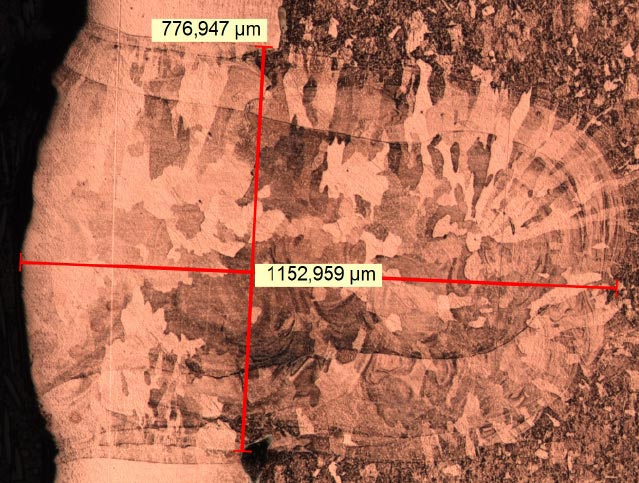
1500 W; 2500 mm/min; with assist gas, Wob: 300 Hz, 0.25 mm radius infocus
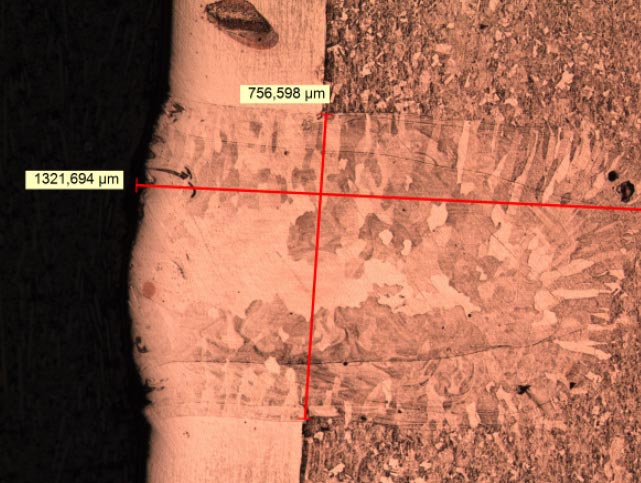
1500 W; 2500 mm/min; without assist gas, Wob: 300 Hz, 0,25 mm radius infocus
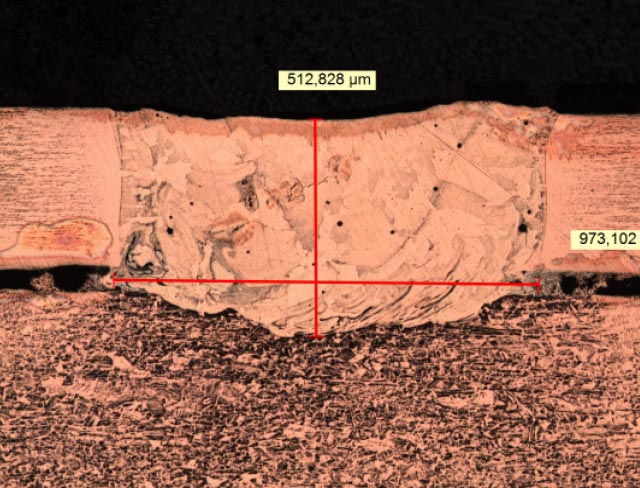
1300 W; 2500 mm/min; with assist gas, Wob: 220 Hz, 0,3 mm radius Defocus +2 mm
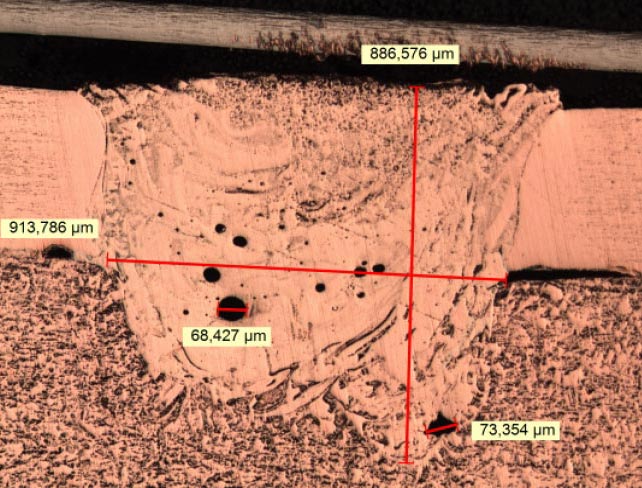
1300 W; 2500 mm/min; without assist gas, Wob: 220 Hz, 0,3 mm radius Defocus +2 mm
The laser beam is in this case mostly „wobbled“, i.e. a circular or spiral feed is generated with which a defined welding line width can be achieved. ”RAYLASE deflection units in combination with our Fujikura fiber lasers have also convinced us that with them a very high wobble frequency is possible. This allows a very even weld bead to be produced at a good feed rate of the weld seam“ points out Manuel Brunner the Divisional Manager Fiber Laser Division of Fujikura Europe Ltd. The result is strong and reliable contact connections.
The configurable optics in the deflection units also help make processes more flexible. RAYLASE product manager Wolfgang Lehmann sums up the benefits: ”The customer is free to select his feed rate based on his application, spatial beam control is easier to adjust, and by wobbling, the joints or gaps can also be connected. The process is characterized by an extremely smooth and stable melt pool.“
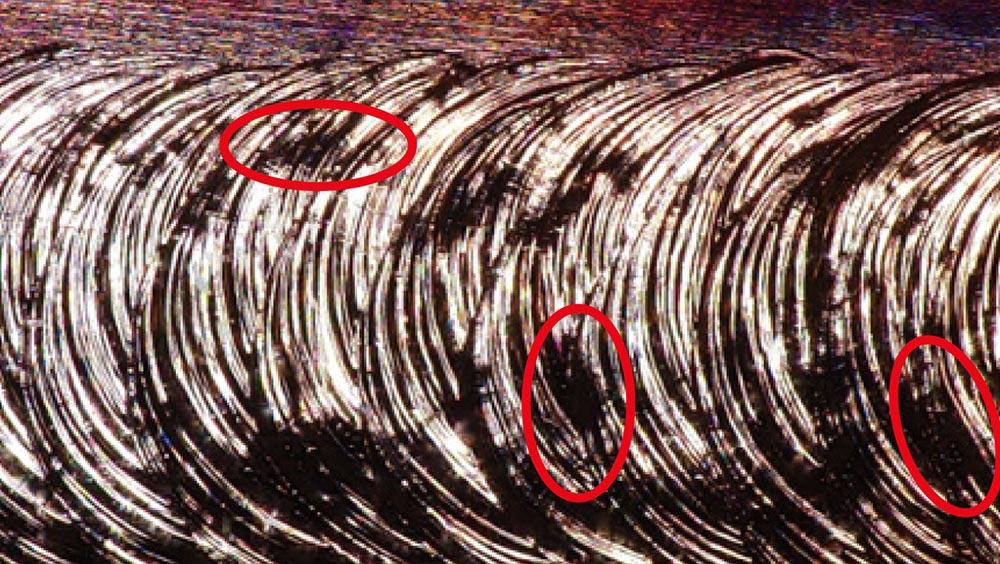
Wobbling: Defocus Unmodified frequency
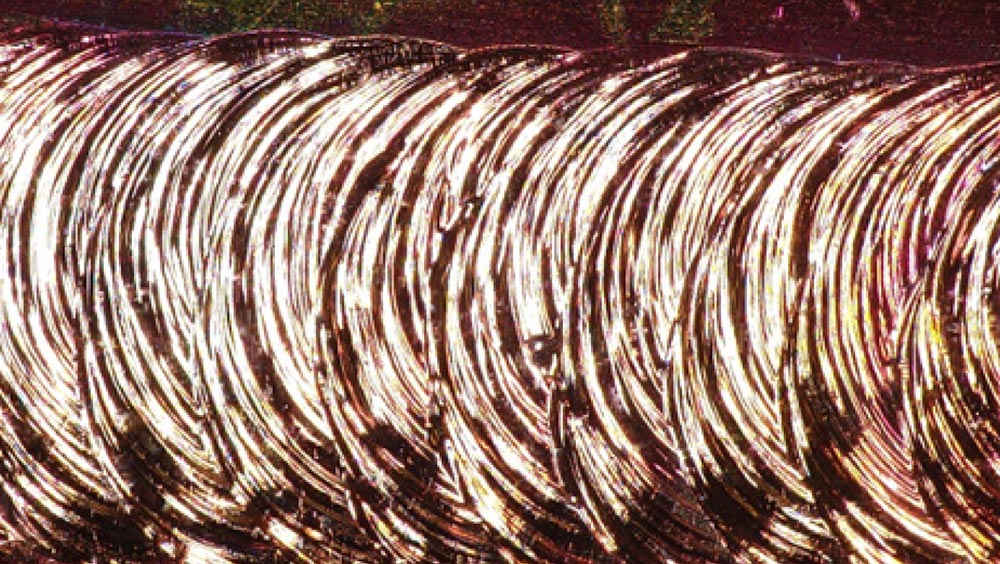
Wobbling: Defocus Reduced frequency
Which laser beam deflection unit is suited to which task?
Which particular system configurations of the deflection unit fit to which job is determined by the individual requirements for power electronics manufacture and the materials and material thicknesses used and, of course, the specific task. In addition, the size of the process field to be processed using a deflection unit plays a significant role in ensuring the highest quality.
SUPERSCAN IV-15 with camera or sensor adapter
Up to 3kW laser power with high wobble frequencies and connection of process sensors available.
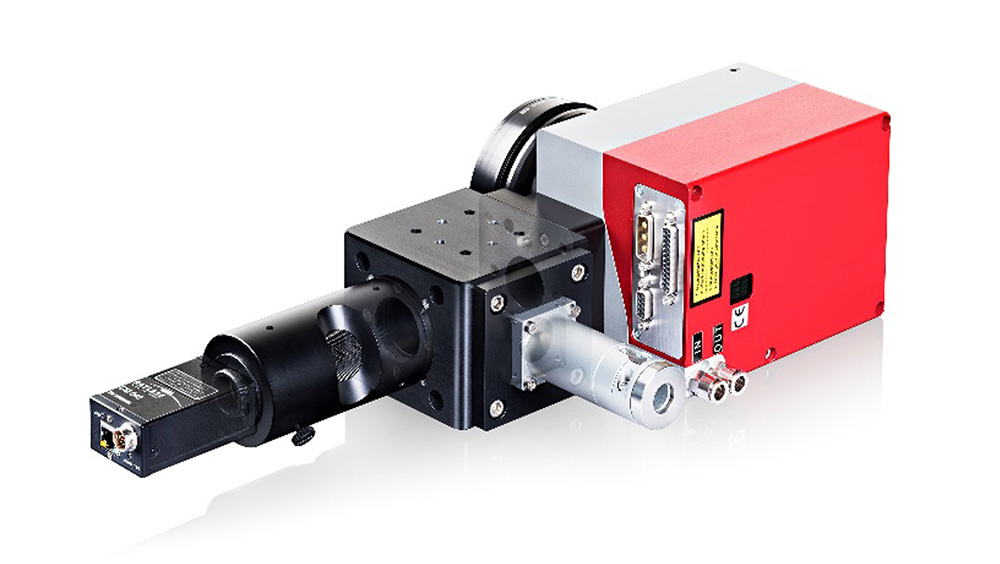
RAYLASE AXIALSCAN FIBER 30 – a premium product for welding processes
One of the stars among the deflection units by RAYLASE is the AXIALSCAN FIBER 30 – a premium product for welding process in e-mobility. The deflection system can be easily integrated into any laser system via different mechanical interfaces from above or below, or with a robot flange to the side. The built-in fiber collimator allows light to be focused into the laser fiber without beam path alignment.
A second external protective window can be quickly and easily replaced. Camera and weld monitoring systems can be adapted to the process light output without wavelength-de- pendent (chromatic) aberrations. All the optics are dust- proof and therefore ideal for use in harsh industrial environments. The AXIALSCAN FIBER is also available with a 20mm mirror aperture.
Besonderheiten
- ”High power“ version for welding in the e-mobility sector
- Dust-proof
- Simple system integration with direct laser fiber connection and multiple mounting options
- ”On-axis” quality control via integrated
”process monitoring” interface - Integrated fiber collimator
- IP64 with second additional protective window
- Integrated sensor and camera monitoring
- Process field sizes: 200mm x 200 mm to 850 mm x 850 mm
- Very large Z range for 2.5-D or 3-D applications
- Up to 4 kW laser power (single and multi-mode)
- Optional air and water cooling
Fujikura fibre laser and RAYLASE deflection units
Just recently, Fujikura Ltd – a Tokyo-listed Japanese multinational and market leader in the development and production of fiber optic systems – established its European Engineering Centre, EEC in Brescia, Italy. Hosted by Tecnosens SpA. Tecnosens is also the European distributor of their lasers. The new platform is a technological centre focused on qualifying laser technology processes for Fujikura fibre lasers. Also part of the team - deflection units by RAYLASE. „The collaboration model developed with RAYLASE we have been gradually expanding for the last 3 years enables us to pass on and implement technological and procedural know- how vertically applicable to electromobility and new strategic segments in which our company already leads on the Japanese corporate market“, explains Keiji Kaneda, Fujikura General Manager.
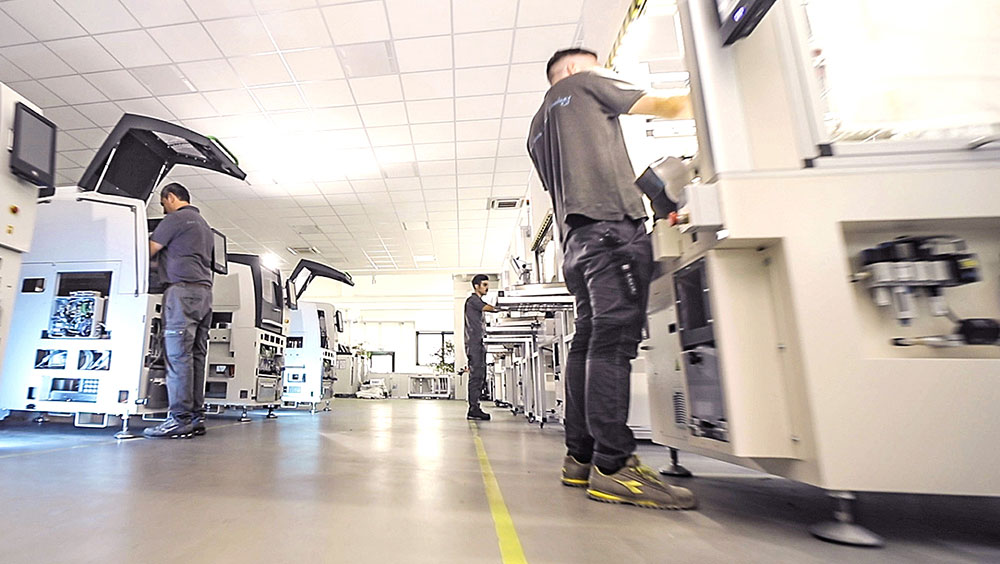
A good team
OSAI A.S. headquartered in Italy, swears by the top performing combination of Fujikura fibre lasers + RAYLASE deflection units. The company with subsidiaries in Germany, China and the USA, has been active in the field of industrial process automation since 1991. For copper welding, OSAI uses press-packs, particularly the SUPERSCAN -IV-15 and the AXIALSCAN FIBER 30. The press packs not only find use in battery management for power electronics, but also as rechargeable batteries or as ultra-capacitor packs. They are employed in modular and mobile electrical infrastructures and frameworks, for example, in semiconductor manufacturing, vertically aligned on electric-voltage battery frames and electric mobile infrastructures.
Luigi Calcagno EMEA manager for business development at Fujikura EEC predicts strong growth for this type of application in high-performance electronics: ”We anticipate very strong momentum and expect a booming market of hundreds to thousands of fibre laser sources in EMEA over the next three to five years.” Paolo Riccardi, sales manager at OSAI agrees: ”We are convinced that there is still huge potential here, especially for manufacturers of the main components in electromobility.“ The solutions offered by OSAI are based both on the most commonly used systems and on special machines for assembling and testing high-tech components for the semiconductor industry, the automotive industry and electronics manufacturing. The combination of Fujikura laser with opto-mechanical scanners from RAYLASE brings many advantages: together they strengthen reliability and performance of the laser process during welding and provide more stability, while at the same time ensuring first-class manufacturing quality. Not to mention very high process awareness on all sides.
